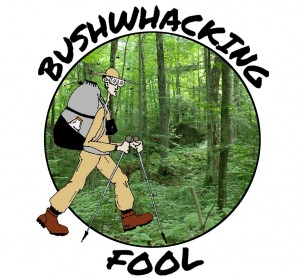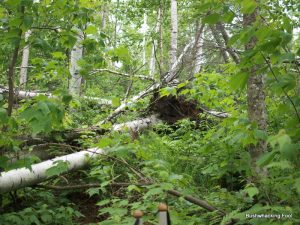
Paper birch blowdown
It was pure naiveté thinking that the initial descent from the ridge between McDonough and Saddleback Mountains would be the most difficult part of my fifth day in the Jay Mountain Wilderness. However, the jungle-like forest and frequent boulders from higher up on the ridge pales in comparison to the scene that now lies before me. A mature paper birch forest that once stood here has been recently replaced with something that strikes fear in the heart of even the bravest of bushwhacker, a devastating blowdown.
These beautiful paper birches, with their chalk white bark, lie about in all manner of chaos. Some of them are uprooted, with their roots pointing to the sky, while others were just snapped off near their base. The whole area appears like a war zone, but with the added difficulty of being on a slope that I still need to navigate. The scene brings back some memories of blowdowns past. This is not going to be easy. Not by a longshot.
Unfortunately, delaying the inevitable is not going to bring me any closer to Merriam Swamp, my final destination for the day. Instead of standing here and whining about it on the periphery, I grit my teeth and dive in headfirst, ready to do battle with nature at its most brutal.
Section Stats:
Date: June 21, 2014
Length: 1.2 miles (2.5 total daily miles; 23.1 total trip miles)
Difficulty: Very Diffcult
At times, I slip underneath the downed stems as they lay suspended off the ground by the debris or terrain beneath them. Others I climb over, placing my shin on the log before vaulting or pivoting over the once great tree. My shins pay me back with scratches, gouges and bruises, but given how I mistreat them, it is only fair. Branches brought down from the upper canopy further impede my progress, slapping me in the face or threatening to poke out an eye.
Good thing I wear safety glasses while bushwhacking, too bad I do not have the sense to say the same about shin guards.
The arduous effort continues with no ceasing in sight. My search for a path of least resistance through the maze of downed trees forces me farther from the stream that had been acting as my guide off the ridge. Occasionally, I glimpse the Jay Mountain range to the north through the shattered canopy, which leaves me envying the ease of travel from that second day of my trip. If I make it out of this mess alive, I should intersect back with the trail come tomorrow. At this point, it cannot come soon enough.
Climbing over and under the once beautiful trees is exhausting work. Resting more frequently and for longer duration as the time pasts within this obstacle course of blowdown is essential to preventing injury, not to mention preserving my sanity.
But then it finally happens. The terrain levels off and through the trees I glimpse a sigh of hope – the sweet relief of space along a stream, free of the crisscross of downed trees and damaged canopy. Salvation, you did not arrive soon enough. My screaming shins echo the sentiment.
Heading for the gap in the downed trees, I climb down a steep drop before exiting onto an open streambank of gravel and sand. The open space, free of banging my legs and shins on downed trees, feels like paradise, the freedom of movement never seemed so sweet. Grass, other herbaceous plants and logs litter the area along the stream, with an occasional young tree, so the going is not like a walk on a road, but it is the easiest stroll I have had for most of the day.
Paper birch snags still stand upright along the stream, not falling prey to whatever windstorm took down their live forest interior compatriots. The Jay Mountain range stands off to the north, dominating the view in that direction, reversing my perspective from when I hiked in along the ridge at the beginning of my journey days before.
Deer tracks litter the sand and silt along the stream; apparently they enjoy the view and the sense of wide open spaces as much as I do. However, no good thing comes without a cost. The black flies appear to enjoy the open or the views as much as the deer and I do given their abundance here. Their constant onslaught shortens my rest, forcing me back into the forest where it is safe from them, but detrimental to my shins.
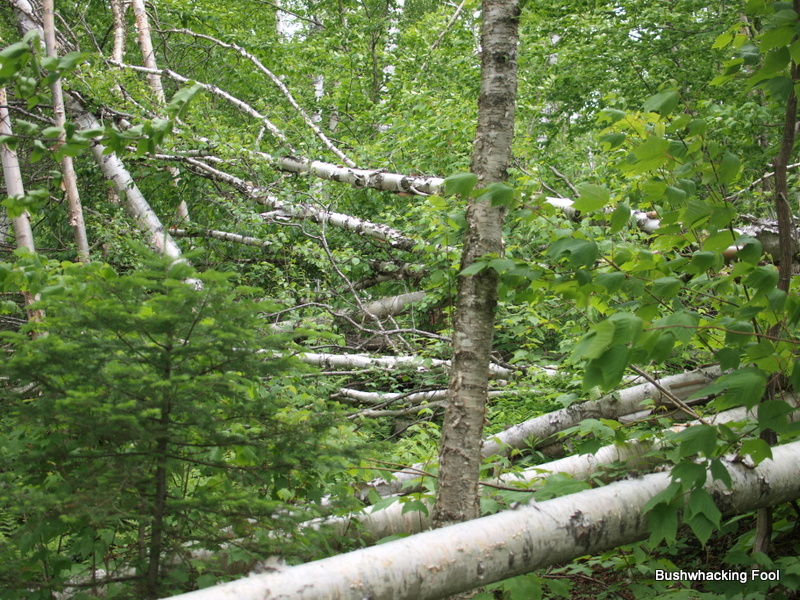
Paper birch blowdowns as far as eye can see
The terrain levels off as the slope dissipates, and surprise, surprise, so does the paper birch blowdown. Although it does not completely disappear, it recedes into the background, with just an occasional downed tree to contend with. Things are starting to look up for me and my shins now.
The stream continues to guide me from inside the forest, but now it changes direction to the southwest. The stream is wide and extensive here, with many paper birch snags standing throughout just like during my recent and brief rest upstream. Grass, ferns and other herbaceous vegetation are abundant, with a network of small streams undulating in every direction imaginable. Above the entire scene is Jay Mountain, still dominating the northern view in an almost foreboding fashion, like a deity ready to make a judgement.
As I continue along the stream, it widens and consolidates its flow, with both the vegetation and the snags diminishing in numbers until mostly open water remains. At this point, it is more pond-like than that of a flowing stream; apparently the heart of Merriam Swamp is drawing near. Paper birch snags still stand in abundance along both shores of the open water, where once forest stood before some beaver decided to come along and compulsively build its dam.
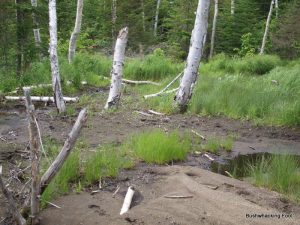
Open space along stream
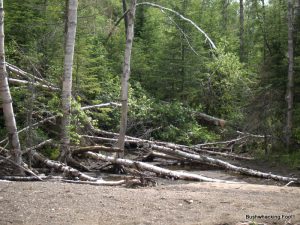
Paper birch blowdown at stream
Young conifers replace the blowdown now, giving me another impediment to preserve over. Fortunately, the forest matures some, giving me an easier time of bushwhacking along the southern shore of Merriam Swamp. When I finally reach the western end of the open water, a meandering dam stymies further travel.
My exhaustion and the dam beg me to stop for the day and set up camp. Plus, my map indicates an old trail leads here from a road to the south, so there should be a campsite nearby. A cursory search of the area on this side of the dam proves less than fruitful in that regard though. Level areas are at a premium here, with most of the area either covered with rocks or sporting a depression. My state of mind quickly follows suit.
A remnant of a plastic bag dissipates all feelings of remoteness despite the surrounding dominating ridge, open water, chalk white snags and surrounding forest, but it does look promising from a campsite point of view. The wilderness spell temporarily broken, I cross the beaver dam to search for the campsite on the other side of the swamp.
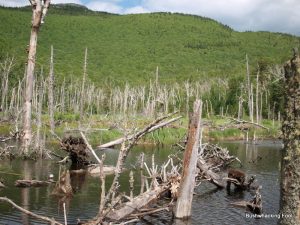
Merriam Swamp
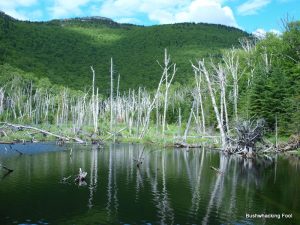
Merriam Swamp
Although the beaver dam seems old and decrepit at first, with little evidence of upkeep or maintenance, an occasional recently bark-stripped limb suggests otherwise. At the midpoint, I stop and take in the commanding view of the Jay Mountain ridge. It stands tall, dominating the scene, which includes many chalk-white paper birch snags clustered together along the opposite end of the open water. The view is intense in its beauty, reigniting my previous sense of remote wilderness, now if I could only find a nice place to set up camp.
A steep climb greets me on the opposite shore after crossing the dam. The slope is bare near the dam, almost totally devoid of trees due to beaver activity. Danger lurks everywhere within the dense ground vegetation though, obscuring the many beaver spikes left behind by the industrious rodent. A search farther upslope reveals nothing but more slope, a terrain totally incompatible with anything remotely resembling a campsite.
Disappointment brings me back to the dam area, where I stop and have a very late lunch. The search for a campsite can wait as it is already mid-afternoon and my hunger demands respect. As I devour my hastily constructed tuna fish sandwich, the plethora of black flies in the area compels me to continue moving as I eat my lunch. A pacing lunch is as familiar as filthy pants at this point in my Adirondack bushwhacking career.
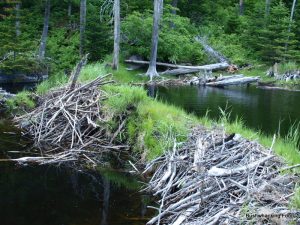
Merriam Swamp dam
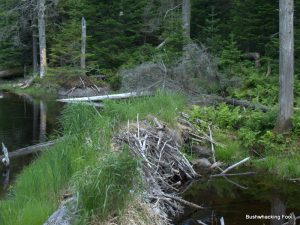
Merriam Swamp dam
While wandering out on the dam after lunch, movement on the farthest open area along the Jay Mountain ridge captures my attention. After scrambling for my binoculars, I scan the area to find its source – a hiker on the way back from Jay Mountain. I compulsively watch his progress, as he/she disappears from one open area, before minutes later reemerging at the next closest one. The free entertainment continues until the traveler disappears from the closest open area, even after taking the trouble to move to the southern side of the open water to get a better view.
The black flies smell vulnerability and they show no mercy as I watch the hiker. This is the worst they have been since starting my trip four days before. The onslaught becomes so intense that I apply some bug repellent for the first time since my adventure began. As much as I hate the stuff, even a little relief at this point makes it more than worth the aggravation.
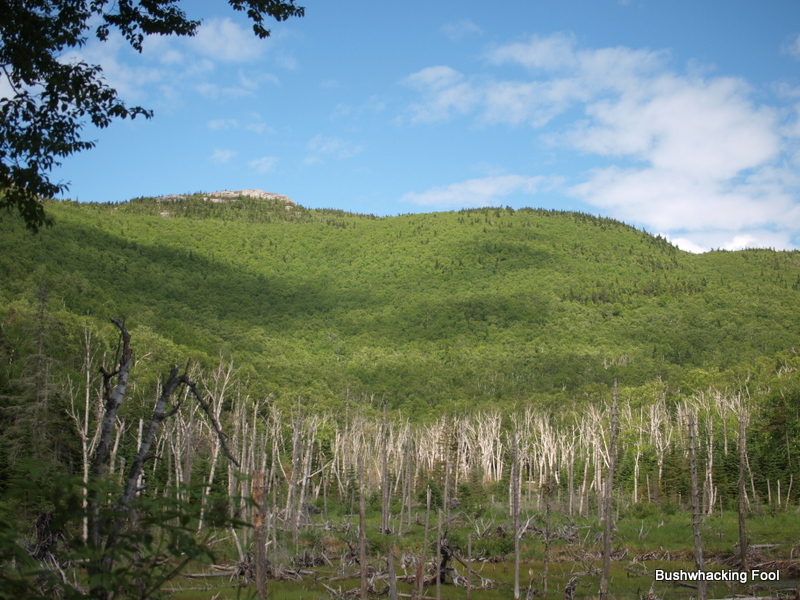
Jay Mountain ridge from dam
Black flies are not the only pest at Merriam Swamp. No-see-ums, mosquitos and deer flies are also present, with the deer flies being worse at the water’s edge, and the other two being peskier in the surrounding coniferous forest. Whether it is the bug dope or the infrequent breeze blowing through, some respite from the onslaught occurs.
Making the best of the situation, I create a campsite underneath a large spruce near the dam along the southern shore. It looks as if deer have bedded down here, as it is devoid of most vegetation. Unfortunately, they did not control their bowels, so I have to scrape away most of their dropping before setting up my tarp. The exposed roots probably will not be very comfortable, but this being my last night in the backcountry, my concern is fleeting.
After wiling away the afternoon hours, the many camping chores cannot be put off any longer. Filtering water is excruciatingly slow, apparently the filter element is clogged with junk (i.e. rich Adirondack decaying organic matter). Luckily, this is probably the last time on this trip for enduring this ritual as long as I filter enough water to get me through tonight and tomorrow morning.
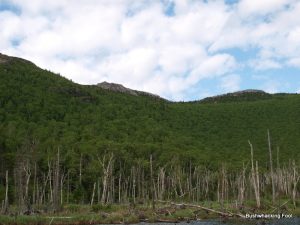
Jay Mountain ridge
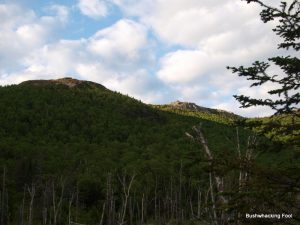
Jay Mountain ridge
Clouds start dominating the sky by evening, with only an occasional flash of blue visible. Listening to the frogs and birds, while watching the clouds move over, provides my entertainment for the evening. The setting sun on Jay Mountain is impressive, bringing out details I missed before. Even some of the cairns are visible from my location, but no other hiker shows up to further entertain me.
My late lunch allows for a light dinner of snacks, with no stove or cooking necessary. When eating is over, I secure my food and settle in under my tarp for the night. The no-see-ums are so bad at this point that I cannot stand to stay out for another moment. The additional rest should give me the necessary energy I need to make it back to the trail tomorrow.
Hopefully, there will not be even a single blowdown present on the whole way out. Fat chance of that!
Affiliate Disclaimer: Some links and advertisements on this blog post and elsewhere on the Bushwhacking Fool may send you to a retailer’s website. If you chose to purchase any product on that site, this author may receive a small commission at no extra cost to you. These commissions provide compensation for the author’s time and effort necessary to provide the content at the Bushwhacking Fool. If you enjoy the content on the Bushwhacking Fool, please show your appreciation by purchasing products through links and advertisements on this site.
